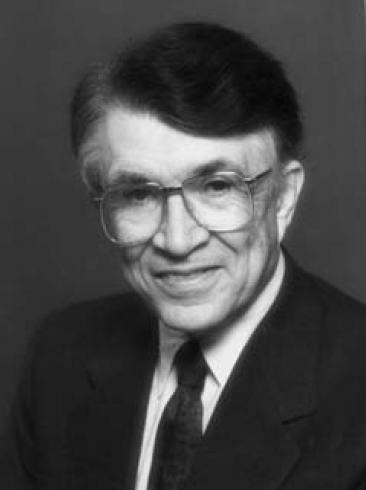
1922–2006
Elected in 1986
“For research into the use of ferrites in microwave components, and for extensive contributions to the research, engineering, and development of military space systems.”
BY WANDA M. AUSTIN
MAX TIBOR WEISS died June 10, 2006, in Los Angeles, California, at the age of 83. At the time of his death, he was survived by his wife Melitta and their three children: sons Herschel and David and daughter Deborah Berkowitz. Other survivors include 19 grandchildren, seven great-grandchildren, and his brother Joseph Weiss. He was predeceased by his eldest son, Samuel.
Weiss was born in Hungary on December 29, 1922, and emigrated to New York City with his family in 1929, just before the beginning of the Great Depression. Like many immigrant families, Weiss’s mother and father pushed education and professionalism as a way for their children to advance themselves in their adopted country. Weiss attended City College of New York from 1940 to 1943, majoring in electrical engineering, and following graduation he joined the U.S. Navy and served as a chief petty officer. When World War II ended, Weis enrolled at the Massachusetts Institute of Technology in 1946 for his graduate studies; he received his master’s degree in electrical engineering and his Ph.D. in physics in 1951.
After receiving his doctorate, Weiss accepted a position at Bell Labs, where he worked for 10 years. While working at Bell, Weiss coauthored a paper with Philip Anderson, who was awarded the Nobel Prize in physics in 1977. Weiss described his tenure at Bell Labs as “a most wonderful experience…And
one of the most important things you learn at Bell Labs is you ask questions, you don’t take anything for granted. If there is a problem, if something unique happens in an experiment, you find out why…. And that questioning attitude was extremely useful to me in all kinds of situations, whether at Aerospace, or Northrop, or in my personal life.”
After leaving Bell, Weiss moved to Los Angeles to work at Hughes Aircraft for two years. He first joined Aerospace in 1961, less than a year after the corporation was founded. Weiss is largely credited with establishing the Aerospace Corporation Laboratories in cooperation with Dr. Ivan Getting, the first president of Aerospace. He later described his move to Aerospace as “exciting times…a tremendous opportunity to fashion the laboratories.” Weiss joined Aerospace as director of the Electronics Research Laboratory and initiated studies of lasers and related electro-optics. “Decision making was quick, and, for example, the laser was invented and within months we had a laser laboratory.” He became assistant general manager of the Laboratories Division in 1963 and was promoted to general manager in 1964. He served in that capacity until 1967, when he left Aerospace to work for TRW, where he directed the microelectronics center.
He returned to Aerospace only a year later at Getting’s request to serve as general manager of the Electronics and Optics Division, where he remained for 10 years. In 1978, during the Aerospace presidency of Dr. Eberhardt Rechtin (1977–1987), Weiss became vice president and general manager for laboratory operations. It was Weiss who decided that Aerospace needed engineering laboratories in addition to its existing research labs. He then served as the Engineering Group’s vice president from 1981 until 1986, when he left Aerospace to work for Northrop Grumman. While employed at Northrop Grumman, Weiss oversaw the research laboratories for one year and then became vice president and general manager in charge of the Electronics Division.
Throughout his long career, Weiss received numerous awards for his research in physics and electrical engineering. He received the Institute of Electrical and Electronics
Engineers (IEEE) Centennial Medal in 1984 and was named an IEEE fellow in 1987. Weiss was elected to the National Academy of Engineering in 1986, based on his research into the use of ferrites in microwave components and for extensive contributions to the research, engineering, and development of military space systems. Weiss’s additional honors included election to fellowships in the American Physical Society and the International Academy of Astronautics.
The IEEE awarded Weiss its Frederik Philips Award in 1993, citing his “leadership in building electronics research and engineering organizations for the development and operation of national security space systems.” Even after his retirement from Northrop, Weiss remained active in the aerospace industry. He was appointed to serve as a council member of the California Council on Science and Technology (CCST) in 2001 and was serving his second term with the council at the time of his death. Always in touch with the latest scientific and technological advances, Weiss served on both the finance and new technologies committees of the CCST. He also served on the Defense Science Board/Air Force Scientific Advisory Board Task Force on Acquisition of National Security Space Programs, which released its findings in the so-called Young Report in 2003. The task force documented some shortcomings with space acquisition policies and urged the U.S. Air Force to continue its reform of the acquisitions process in order to field satellite systems on time and within budget.
In an interview conducted in 2005, Weiss was asked which career honor he was most proud of and he replied, “Probably election to the National Academy of Engineering, which came as a total surprise to me…. It was extremely satisfying, and of course that is one of the highest honors that any engineer can have.” Reflecting on his career with the Aerospace Corporation, Weiss recalled a year before his death that “it was an exciting time for the space program, so I enjoyed it immensely. I think I made some contributions…. And on the whole I’m very, very grateful for the opportunities that both Eberhardt Rechtin and Ivan Getting gave me. So clearly I had an impact, and that is extremely satisfying.”




